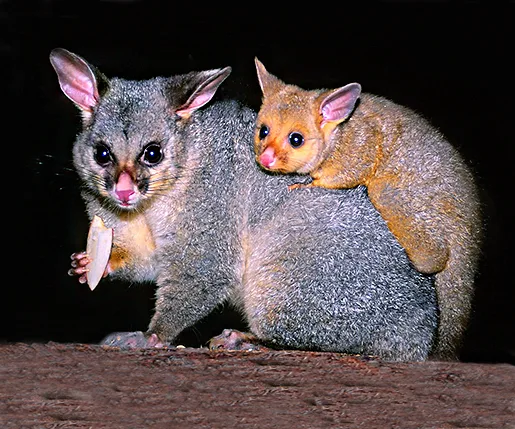
What Is a Possum?
Possums are nocturnal Australian marsupials with fluffy tails, sharp claws for climbing, and large, luminous eyes perfectly adapted for life after dark. Their fur, soft and sleek, varies in colour from silvery grey to deep chocolate brown or black, depending on the species.
Possums come in all sizes—from the minuscule pygmy possum, scarcely larger than a thumb at just 70mm (2.8 inches) long and weighing only 10g (0.35oz), to the impressive brushtail possum, which can stretch over a meter (3.3ft) and weigh up to 10kg (22lbs).
Possums are shy, solitary, territorial animals. They are generally not aggressive, preferring to stare down their opponent silently rather than get involved in serious altercations. However, they can be violent if provoked, clawing and biting their attacker.
Possums are marsupials and give birth to tiny, underdeveloped young that continue growing safely tucked inside the mother’s pouch—just like kangaroos and koalas. Possums have a lifespan of 5-8 years. While they may share a name, they are only distantly related to the opossums of the Americas.
List of Possums
Australia is home to over 20 species of possums. Here are some of the most well-known:
Ringtail Possum
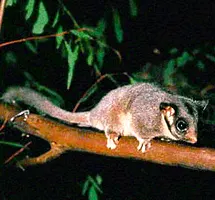
The ringtail possum is about the size of a cat. It has a prehensile tail with which it grabs onto branches. This possum holds it in a tight coil when not using its tail to grasp onto things. This is why it’s called a "Ringtail" possum. It feeds on a wide variety of eucalypts, flowers, fruits, and nectar.
Read More About Ringtail PossumsSugar Glider
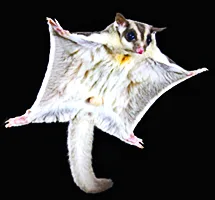
The sugar glider is a small arboreal marsupial mammal. It has a very thin skin, called a membrane, that it spreads out to glide from tree to tree. It feeds on nectar from flowers, insects, and tree sap, which it gets by biting the branches of gum trees.
Read More About Sugar GildersLeadbeater's Possum

The Leadbeater's possum is about 300mm long and weighs about 140g. It is a quiet, shy, fast-moving marsupial that runs along branches in the forest canopy. It eats insects, manna, honeydew, and tree sap. They build out of shredded bark in the hollows of trees.
Read More Leadbeater PossumsBrushtail Possum
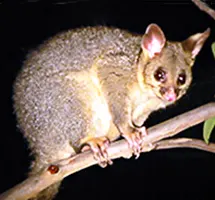
The brushtail possum is a semi-arboreal, nocturnal marsupial. Its fur is thick and woolly and varies from silver-grey, brown, black to cream. It has a bushy prehensile tail, which it uses to grasp onto branches. It eats leaves, flowers, fruits, and insects.
Read More About Brushtail PossumsFeathertail Glider
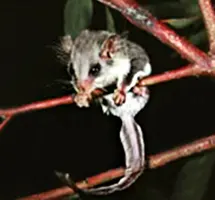
The feathertail glider is the smallest gliding possum. It is called the Feathertail because its tail looks like a feather. It uses its tail to balance and steer while gliding. It has very thin skin attached from each elbow to the knee. It spreads this membrane out to glide. It lives mainly on the tops of eucalyptus forests and eats nectar, manna, and small insects.
Pygmy Possum
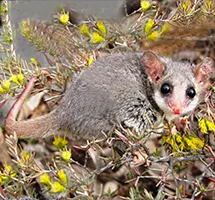
The pygmy possum feeds mainly on nectar and pollen, which it gathers with a brush-tipped tongue and fruit and insects. It is not very fast, but it is an excellent climber, using its prehensile tail to grip a branch while climbing or feeding. It nests in small tree holes, which it lines with shredded bark. It also nests in old birds' nests.
Where Do Possums Live?
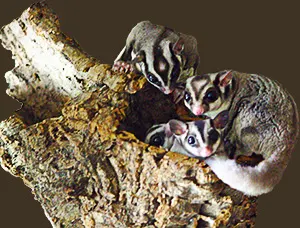
Photo: Possum sheltering in tree hollow
Being arboreal (tree-dwelling) creatures, possums are commonly found in forests, woodlands, and even suburban neighbourhoods, throughout the eastern and south-eastern parts of Australia, ranging from the rainforests of Queensland to the eucalyptus forests of Victoria. Possums also live in Papua New Guinea and Sulawesi. In recent times, they have also been introduced to New Zealand and China by humans.
Possum's Natural Habitat
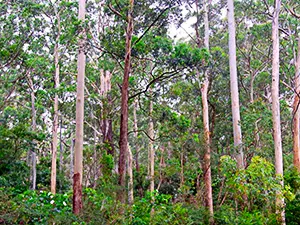
Photo: Eucalyptus forest
Possums prefer the dense foliage of trees and rarely come down to the ground. They build their nests high above ground. These nests are built in tree hollows and dense foliage and lined with shredded bark, twigs, and leaves. Some of the smaller species of possums, such as the sugar glider, may share a nest with up to eight others.
Possum's Urban Habitat
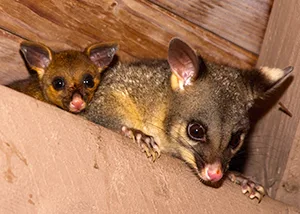
Photo: Possums in ceiling
With urban sprawl and the destruction of the possums' natural habitat, many possums have been making themselves at home in suburban areas. Urban possums are especially fond of the warm cosy buildings humans construct. Some are known to pull off roof tiles and squeeze through openings in roofs and build themselves nests in ceilings of houses, garages, sheds, and even chimneys. These urban possums can be a huge nuisance to homeowners. Brush tail and ringtail possums, in particular, have come to like the comforts of urban living.
Urban possums can be an absolute nuisance. They can be noisy by clambering over roofs at night, destructive by urinating and defecating in ceilings and other areas around buildings giving the whole area a terrible stench, tearing up heating ducts and insulation, raiding chick copes and garbage bins and creeping through people's gardens.
What Do Possums Eat?
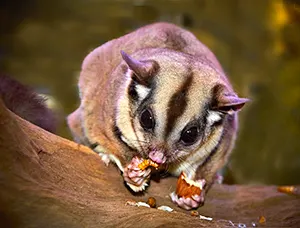
Photo: Possum eating
Possums are omnivores. They eat almost anything edible—dead or alive.
Possum's Natural Diet
In their natural environments, possums eat leaves, flowers, fruits, grass and fungi. They also eat lizards, insects, bird eggs and baby birds.
Possum's Urban Diet
Unfortunately, these crafty possums are greatly attracted to suburban garbage bins and gardens. In domestic gardens, they will eat almost anything from flowers such as roses, camellias, magnolias; to fruits and vegetables such as mangoes, apples, pears, grapes, melons, lettuce, tomatoes, carrots and shrubs and small trees such as wisteria and wattle.
The Story of 2 Ingenious Possums
There is a story of two cunning possums who hatched an ingenious scheme to get their little paws on some delicious vegetables in a protected urban vegetable patch. One possum hung on to an overhanging branch with its back legs, grabbed onto its accomplice's rear legs with its front paws and lowered its partner down to snatch the vegetables.
Possum vs Opossum
Both possums and opossums are marsupials and share a common ancient ancestor, but they are significantly different from each other. Possums are primarily found in Australia while opossums are found in the Americas.
So in proper usage, the Australian animal is a possum, and the American animal is an opossum.
A male possum is called a jack
A female possum is called a jill
A baby possum is called a joey
The Story of How the Possum and Opossum Got Their Names.
While in Jamestown Virginia in North America in early 1608, Captain John Smith (who Pocahontas saved from death - remember the Disney movie) described an unusual animal that carried its young in a pouch in its abdomen.
He called the strange animal "Opassom". He
derived this name from the Algonquian American Indian language which called this animal "apasum" meaning white animal. By 1613 the name appeared in print with the "o" dropped off, becoming
simply "possum". It has been used as a colloquial term in North American ever since.
Joseph Bank, a naturalist, who accompanied Captain James Cook on the sailing ship the Endeavour arrived in Australia in 1770. When Banks observed a tree-climbing marsupial he noted it as "an animal of the Opossum tribe" because of its similarity to the opossum of North America. Again, soon, the 'o' disappeared and the Australian animal was referred to as a possum too.
In time, it was determined that while both animals were marsupials, they were very different indeed. As a consequence, the American opossum was classified under the scientific name Didelphimorphia and the Australian possum under the scientific name Phalangeridae.